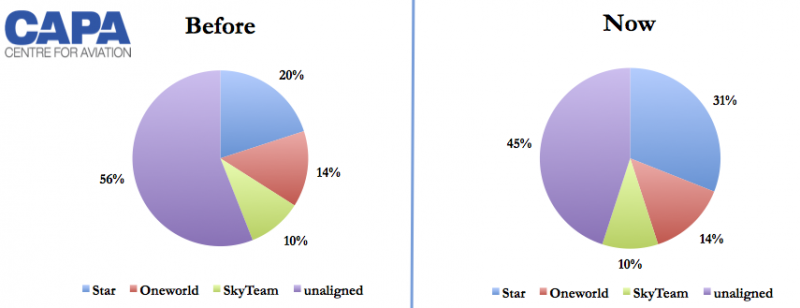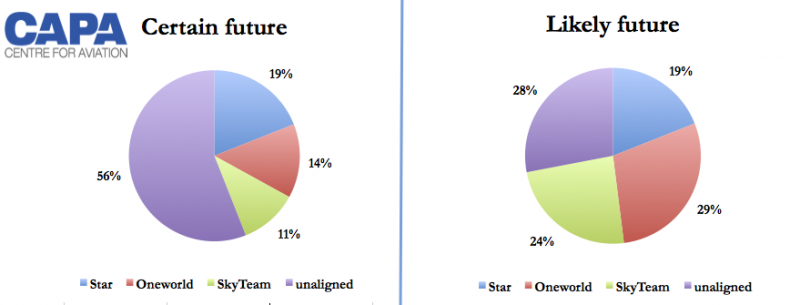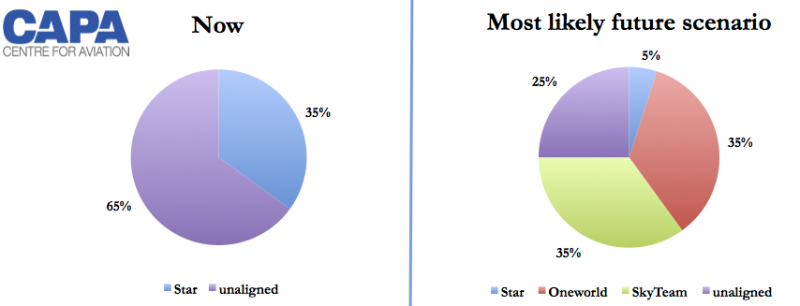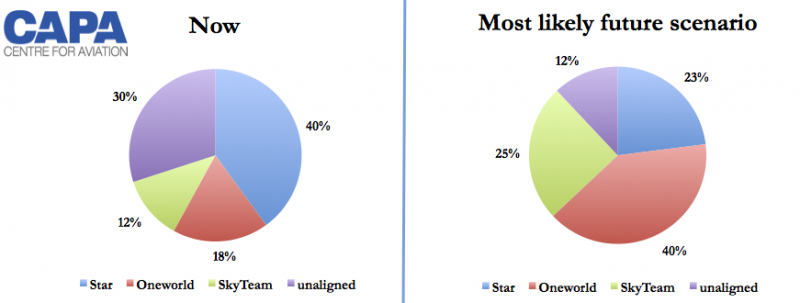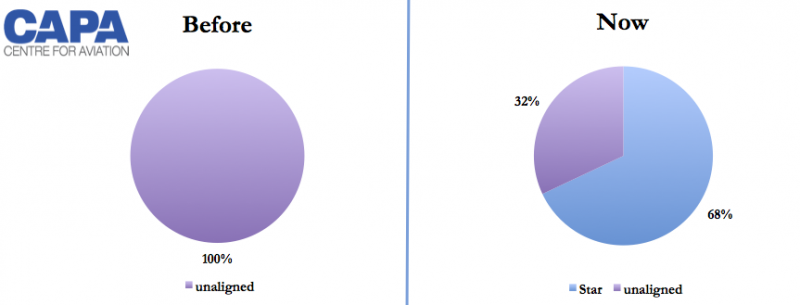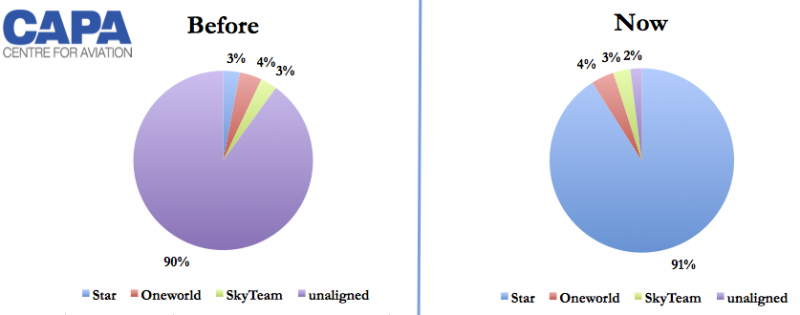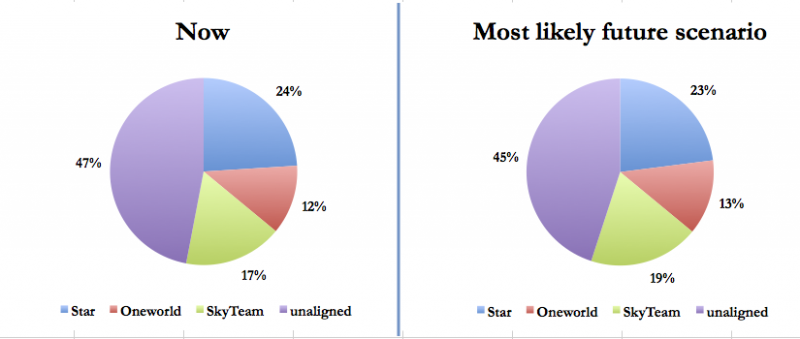Avianca-TACA and Copa put Star on top in Latin America but the victory will be short-lived
Six carriers from Latin American airline groups Avianca-TACA and Copa are formally entering the Star Alliance on 21-Jun-2012, marking the first of several key alliance movements in the fast-growing Latin American market. The six carriers - which include two from Colombia and one each from Costa Rica, El Salvador, Panama and Peru - will temporarily widen Star's market-leading position in Latin America. But the gain will not offset the upcoming loss of Latin America's largest airline TAM, which will be exiting Star within 24 months. Star would find itself as the third biggest alliance in the key Latin American market under the increasingly likely scenario of TAM joining new sister carrier LAN in oneworld and Brazil's other major carrier, Gol, being affiliated with SkyTeam.
Star has enjoyed the status of Latin America's largest alliance since TAM joined in May-2010. Star has since accounted for about 20% of total capacity in the Latin America and Caribbean region, compared to about 14% for oneworld and 10% for SkyTeam.
- Six carriers from Latin American airline groups Avianca-TACA and Copa are joining the Star Alliance, increasing Star's market share in Latin America and the Caribbean by about 11 percentage points to 31%.
- The gain in market share will not offset the upcoming loss of TAM, Latin America's largest airline, which will be exiting Star within 24 months.
- Star's capacity share in Latin America and the Caribbean will slip to about 19% within two years, making it the third biggest alliance in the region.
- If TAM joins oneworld, oneworld's capacity share in Latin America and the Caribbean will increase to 28%.
- SkyTeam could overtake Star in Latin America if it successfully recruits Gol, the second largest carrier in the region, and Aerolineas Argentinas.
- The battle over Latin America's airline alliances will be completed once TAM and Gol make their alliance selections, leaving only about 28% of total capacity in the region unaligned.
The Avianca-TACA and Copa groups will for now increase Star's market share in Latin America and the Caribbean by about 11 ppts to 31%, according to Innovata and CAPA data. Panama-based Copa Airlines and sister carrier Copa Colombia combined now account for almost 4% of total capacity (seats) in the Latin American/Caribbean market. Colombian carrier Aviana accounts for almost 5% of capacity in the region while the TACA-branded carriers from Costa Rica, El Salvador and Peru combined will contribute slightly over 2 ppts to Star's capacity share in the region.
Latin America/Caribbean capacity share by alliance (% of seats): Before and now
Star's share of Latin America to slip back to under 20% after TAM exits
Star will gain about another 2 ppts in Latin American capacity share as part of a second phase that will bring three additional Avianca-TACA carriers into the fold: Avianca Brazil, Ecuador's AeroGal and TACA Regional Guatemala (also known as Aviateca). But by the time this occurs, TAM will likely have exited Star. As TAM accounts for about 14% of total capacity in the Latin America and Caribbean region (including the TAM Paraguay unit), the total 13 ppts increase in Latin America capacity share that will eventually come from the entire Avianca-TACA and Copa groups joining Star will fail to entirely offset the loss of TAM.
As a result, Star will see its capacity share in Latin America and the Caribbean slip to about 19% within two years. Under a scenario in which TAM becomes unaligned, which is possible for an interim period and conceivable but not very likely for the medium to long term, Star will continue to be bigger than rival oneworld in this key region.
But if TAM ends up entering oneworld, which is the most likely medium to long-term scenario, that would boost oneworld's capacity share in Latin America and the Caribbean to 28%. A further increase for oneworld of about 1 ppt to 29% would be secured if LAN's new Colombian subsidiary, which is currently unaligned, joins LAN Argentina, LAN Ecuador and LAN Peru in the oneworld affiliate membership programme.
SkyTeam, meanwhile, could also end up overtaking Star despite its current distant third position in Latin America. SkyTeam stands to see a capacity share gain in the Latin America and Caribbean market of over 1 ppt on 29-Aug-2012, when Aerolineas Argentinas becomes the second SkyTeam member from the region after Aeromexico. SkyTeam is now courting Gol and is confident the Brazilian carrier will also join SkyTeam within the next few years, which would more than double SkyTeam's capacity share in the region to 24% as Gol is the second largest carrier in Latin America and the Caribbean with about a 13% share of total capacity (excludes Gol's new subsidiary Webjet, which at least for now is expected to remain a separate entity and accounts for about another 2% of total capacity in the region).
Latin America/Caribbean capacity share by alliance (% of seats): Certain future and likely future
The upcoming rapid changes in the region's overall alliance market share figures are primarily driven by the shuffling in Brazil, which is by far the largest market in Latin America. TAM, Brazil's largest carrier, is required to shift alliances as a result of a decision last year by Chile's antitrust court TDLC, which in approving the merger of LAN and TAM included a condition that new Latin American airline group LATAM could not be in the same global alliance as Avianca-TACA. Now that Avianca-TACA has formally joined Star, TAM legally cannot remain in Star and it is not feasible for LAN to leave oneworld for Star.
See related article: oneworld favoured with more at stake than Star in LAN-TAM alliance decision
TDLC's ruling on the LAN-TAM merger, which was upheld by Chile's Supreme Court in Apr-2012, gives LATAM a period of 24 months to adhere to the requirements related to alliances. The ruling also prohibits a dual alliance option, forcing LATAM to pick one global alliance for all its carriers or have some or all of its carriers become unaligned. With Star not an option for any of the subsidiaries or affiliates under LATAM because of the Avianca-TACA conflict, that essentially leaves the new airline group with oneworld, SkyTeam and unaligned options.
LATAM plans to make alliance decision in six to 12 months
LAN and TAM are expected to complete their merger, which was initially agreed only three months after TAM formally entered Star in 2010, by the end of Jun-2012. The chief of LAN's international division, Damian Scokin, told CAPA at last week's IATA AGM in Beijing that LATAM expects to make an alliance decision in the next six to 12 months. Mr Scokin says a decision needs to be made by mid-2013 at the very latest because LATAM has to factor in the implementation time for an airline to switch alliances. The 24 months provided by TDLC, which starts ticking as soon as the merger transaction is completed, includes the implementation phase.
Mr Scokin says LATAM is reviewing the nonaligned, oneworld and SkyTeam options and acknowledges Star is not a possibility due to the TDLC requirement. But in reality SkyTeam at this point does not seem to be a viable option, particularly given SkyTeam executives statements at last week's IATA AGM relating to TAM rival Gol. SkyTeam managing director Michael Wisburn says the alliance seeks to fill one of the biggest remaining white spots in its network, Brazil, by offering Gol participation in the alliance. Mr Wisburn adds that SkyTeam hopes Delta Air Line's recent acquisition of a minority stake in Gol, which gave SkyTeam member Delta a seat on Gol's board, will help persuade Gol to accept SkyTeam's invitation.
Gol already codeshares with Delta as well as SkyTeam members Air France-KLM and Aeromexico. Gol also is now working on implementing a codeshare with incoming SkyTeam member Aerolineas Argentinas.
See related article: Delta's investment in Gol has broader has SkyTeam and broader Latin American implications
Gol has previously stated it prefers to remain nonaligned, a status which now allows it to feed carriers from all alliances (Gol currently codeshares with SkyTeam and oneworld members as well as nonaligned carriers). But once Avianca Brazil enters Star and if TAM ends up in oneworld, Gol will have limited options as oneworld members serving Brazil will be compelled to work with TAM while Star members serving Brazil will be compelled to switch from TAM to Avianca Brazil rather than start working with Gol.
As a result, Gol's decision on whether to stay unaligned or accept SkyTeam's invitation could hinge on whether TAM becomes unaligned or decides to join oneworld. Mr Scokin confirms that having LAN stay in oneworld while having TAM become unaligned is an option now being reviewed by LATAM. This scenario could be attractive as it could allow TAM to continue codesharing with the over 10 Star members serving Brazil. Joining oneworld could force TAM to end these relationships but it is also possible for TAM to broker carve outs as part of a deal for joining oneworld, something oneworld would likely agree to given the value TAM would add if it became a member.
If TAM joins oneworld, the oneworld alliance would have about a 35% share of capacity in Brazil's domestic market and a leading 40% share of capacity in Brazil's international market, up from current respective figures of zero and 18%. If Gol joins SkyTeam, the SkyTeam alliance would also capture about a 35% capacity share of Brazil's domestic market and a 25% share of the country's international market, up from zero and 12% currently. If new Gol sister carrier Webjet, which only operates domestically, also ends up joining SkyTeam the alliance would end up with about a 40% capacity share in Brazil's domestic market.
Brazil domestic capacity share by alliance (% of seats): Now and most likely future scenario
Brazil international capacity share by alliance (% of seats): Now and most likely future scenario
Star will see its capacity share of Brazil's domestic market drop from about 35% to 5% as TAM exits and Avianca Brazil joins while its share of the country's international market will drop from about 40% to 23%. A further drop is possible if TAP Portugal, which has a large operation in Brazil with 10 destinations, also ends up leaving Star. The Portuguese Government is currently in the early phases of finding a buyer for TAP, with possible suitors including Star member Lufthansa but also LATAM and British Airways/Iberia parent IAG from outside Star. TAP currently works with TAM but TAP CEO Fernando Pinto told CAPA at last week's IATA AGM that Avianca Brazil could be a potential alternative.
TAM's exit from Star paves the way for Avianca Brazil
Avianca Brazil was initially excluded from Star's approval in 2010 of Avianca-TACA due to an objection by TAM, which preferred not to see a second Brazilian carrier join the alliance. While Avianca Brazil is much smaller than TAM, it is growing fast and covers almost all the major trunk routes in Brazil including from the main international gateway of Sao Paulo Guarulhos. As a result, Avianca Brazil should be able to give the feed and domestic coverage the Star carriers serving Brazil need.
Avianca Brazil, which for now is almost an entirely domestic carrier, is also eager to join Star for the onward domestic feed from inbound international Star flights. Those passengers will help it in its ongoing domestic expansion. Star has not yet set a date for Avianca Brazil to join the alliance but it is expected to soon start the implementation process.
See related article: Avianca Brazil accelerates expansion as ex-LAN A318s and A320s are added to fleet
Unlike Avianca Brazil, AeroGal was initially accepted in 2010 as a member of Star but Avianca-TACA subsequently elected to hold off on AeroGal joining until it completed a restructuring at the Ecuadorean carrier. With the restructuring now complete and Avianca-TACA having completed the process of joining Star at its main subsidiaries, AeroGal will soon start the process of joining Star. But a date has not yet been set for AeroGal to formally join and it is unclear if it will join before or at the same time as Avianca Brazil.
According to Innovata data, Star previously only had a 1% share of capacity in the Ecuadorean market. This share grows to about 18% as a result of Copa, Avianca and TACA joining Star as all three have relatively large presences in Ecuador. Once AeroGal also joins Star, the Star Alliance's market share in Ecuador will roughly double to 36%, surpassing the approximately 32% share of the market now captured by oneworld. AeroGal is currently the third largest domestic carrier in Ecuador, behind independent government-owned carrier TAME and oneworld affiliate LAN Ecuador. AeroGal also has a small international operation.
The final future member of Star from the Avianca-TACA group, Aviateca, is one of four small turboprop carriers which comprise the TACA Regional consortium. For now Avianca-TACA does not expect Star membership from the three other TACA Regional carriers: Islena from Honduras, La Costena from Nicaragua and Sansa from Costa Rica (TACA Regional also included Aeroperlas of Panama, Aeroperlas, until that carrier was shut down earlier this year). The impact of Aviateca joining is marginal given its tiny size although it will boost Star's market share in the very small Guatemala market.
Star to dominate Colombian market
The biggest impact of Avianca-TACA and Copa joining Star comes in Colombia and in neighbouring Panama. Bogota is by far the biggest hub for Avianca-TACA, dwarfing the group's three smaller hubs in San Salvador, El Salvador (where new Star member TACA International is based); San Jose, Rica (where new Star member LACSA/TACA Costa Rica is based); and Lima, Peru (where new Star member TACA Peru is based).
Avianca is by far the largest carrier in Colombia, accounting for 59% of domestic capacity (seats) and almost 40% of international capacity based on 1Q2012 figures from Colombia's CAA. Copa Colombia, meanwhile, is the third largest carrier in the Colombian domestic market with an 8% share of capacity and is the country's second largest international carrier with a 17% share of capacity.
Having Avianca and Copa Colombia joining Star simultaneously is unusual as there are few if any markets the size of Colombia that have two airlines from the same alliance. But Avianca and Copa started codesharing last year and seem content with being partners and competitors at the same time. The only significant overlap in their networks is on a handful of domestic trunk routes as Copa has reduced its domestic capacity in Colombia in recent years and is now focused primarily on international traffic, which it primarily routes via Panama City as Copa Colombia links Panama City from several cities throughout Colombia and only has a handful of point-to-point international routes.
Copa and Copa Colombia combined now account for 19% of international capacity in Colombia (while Copa Colombia accounts for 17%, Panama-based sister carrier Copa Airlines accounts for another 2%). With Avianca accounting for almost 40% and the TACA carriers contributing another 5%, Star overnight saw its share of this market surge from only 4% to 68%. Once AeroGal also joins the alliance, Star will see its share of Colombia's international market surge another 4 ppts to 72%.
Colombia international capacity by alliance (% of seats): Before and now
Domestically in Colombia, Star now enjoys a 68% share of capacity as a result of Avianca and Copa Colombia both joining the alliance. oneworld and SkyTeam are currently not present in the Colombian domestic market but LAN Colombia, Colombia's second largest domestic carrier, could later join oneworld as an affiliate member.
LAN Colombia now accounts for about 22% of domestic capacity in Colombia, way behind Avianca's 59% share and well ahead of Copa Colombia's 8% share. But the market shares for all three of these carriers will likely decrease over the next couple of years as LCC start-up VivaColombia, which launched services in May-2012, quickly expands.
See related article: VivaColombia takes off in hotly contested fast-growing Colombian market
Colombia domestic capacity by alliance (% of seats): Before and now
LAN acquired former LCC Aires in late 2010 and rebranded it LAN Colombia in late 2011 after completing a restructuring and implementing LAN's typical full service business model. Mr Scokin told CAPA that LATAM will decide on whether and when to bring LAN Colombia into oneworld after it decides on an alliance for TAM. It would be logical for LATAM to seek affiliate oneworld membership for LAN Colombia given that LAN's subsidiaries in Argentina, Ecuador and Peru are all now oneworld affiliates while Chile-based LAN is a full member of the alliance.
LAN Colombia is now primarily a domestic operator and has a small international operation which in 1Q2012 only accounted for 1% of Colombia's total international capacity. But the carrier is planning to expand its international network, which could significantly boost oneworld's current 14% share of Colombia's international market if and when LAN Colombia becomes an affiliate member of the alliance.
Star to dominate in Panama, a critical hub for intra-Latin America traffic
In Panama, Star has recorded an even bigger gain in market share as a result of Avianca-TACA and Copa joining the alliance. Star previously only accounted for 3% of capacity in Panama and now accounts for an overwhelming 91% of total capacity. Most of this gain is driven by Copa, which has about 84% capacity share at the country's only international airport in Panama City, while Avianca, TACA and LACSA combined now account for over 4% of Panama's capcity.
Panama capacity share by alliance (% of seats): Before and now
While Copa is a relatively small carrier, its Panama City hub is extremely valuable to an alliance because it is the leading hub for intra-Latin America international traffic. Copa is the fifth largest airline group in the region behind LATAM, Gol, Avianca-TACA and Aeromexico but it is the largest in terms of intra-Latin America international capacity (with almost a 25% share of capacity). Copa currently serves 60 destinations from its "hub of Americas" in Panama City, including 49 in Latin America and the Caribbean and 11 in North America, giving Panama City the distinction of having the most international destinations in the region.
See related article: Panama's Copa pursues more rapid expansion with Las Vegas, Curacao, Liberia and Recife
Copa was previously a member of SkyTeam but left SkyTeam in 2009 along with its largest bilateral partner and former shareholder, Continental Airlines. Continental immediately joined Star but Copa initially decided to be unaligned. United, which completed its merger with Continental last year, has acted as Copa's sponsor into Star.
Avianca-TACA's membership in Star has been sponsored by Lufthansa, which launched flights to Bogota in 2010. El Salvador-based Grupo TACA originally sought membership in Star several years ago but was initially rebuffed. Its merger with Avianca, which was completed in early 2010, made TACA a much stronger alliance candidate and it was able to convince Avianca, which initially was looking to stay unaligned, of the benefits of seeking joint membership in Star. As Latin America's third largest airline group after LATAM and Gol, the benefits of having Avianca-TACA in Star were obvious to the group's existing members.
While Avianca, TACA and Copa joining Star have big implications in the increasingly important Latin American market, globally the impact is minimal. Copa and TACA are all narrowbody operators and do not have any services outside the Americas. Avianca operates widebodies but its intercontinental network is limited to Barcelona and Madrid in Spain.
On a global level, the addition of Avianca, TACA and Copa increases Star's share of total capacity by only about 1 ppt to 24%. But it stands to lose this gain once TAM exits, leaving it again with 23% share of global capacity.
While Star is in danger of losing its leading status in Latin America, globally it will remain firmly entrenched as the world's largest alliance.
Global capacity share by alliance (% of seats): Now and most likely future scenario
Alliance battle over Latin America draws to a close
Once the key Brazilian market is settled with TAM and Gol making their anticipated alliance selections of oneworld and SkyTeam, the battle over Latin America will be completed. It was a ferocious but relatively short-lived battle as Latin America has gone in just a few years from being almost entirely unaligned to likely the world's most aligned region.
Assuming TAM and Gol enter oneworld and SkyTeam, only about 28% of total capacity in the Latin America and Caribbean regional will remain unaligned. Among only Latin American carriers, approximately eight out of every 10 seats will be aligned. In the remaining unaligned group are predominately small carriers that would be of limited interest to global alliances (the only possible exceptions could be Mexican LCCs Interjet and Volaris, which could be of interest to oneworld or Star given Mexico's only network carrier is in SkyTeam). As a result, the Latin America chapter of the book on global alliances has essentially now been written, and Star Alliance is not necessarily the victor.
